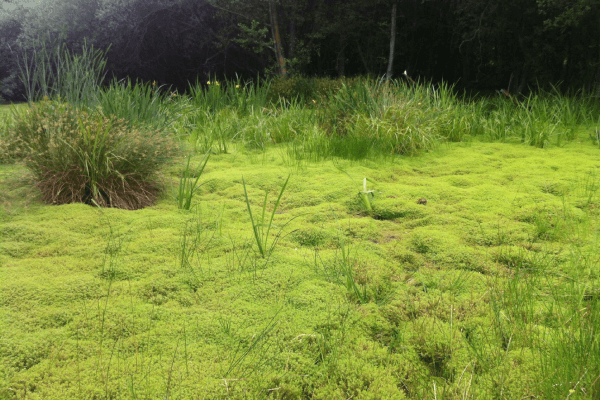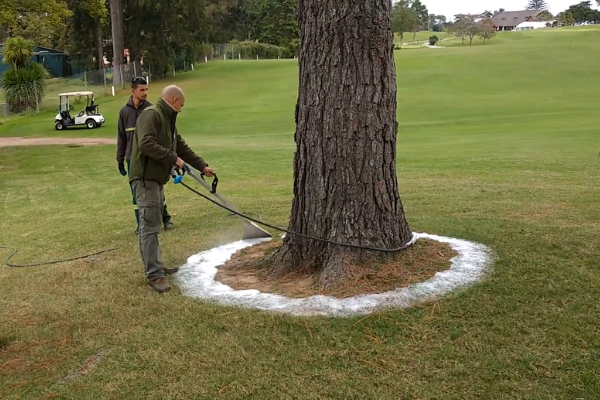Weeds are considered a general pest for any outdoor space, but how do you know which weeds are invasive and how to control them?
The list of invasive weeds is vast, and there are a number of weeds that are particularly invasive, all of which makes controlling them a challenging task to say the least. In this blog, we outline some of the most common invasive weeds, explaining how to spot them, why they are problematic, and how we can help you control and eradicate them.
Japanese knotweed (Fallopia japonica)
Japanese knotweed is a fast growing weed with creeping underground roots or rhizomes. In the spring, you will see thick purple/red shoots at ground level coming from red/pink buds. The plant will then grow rapidly in the summer months to produce tall canes similar to bamboo. These canes are flecked with purple and can reach up to 2.1m (7ft) in height. Each cane produces branches along its length and with heart shaped leaves growing in a zigzag pattern across the stem. Japanese knotweed flowers in the late summer or early autumn with small creamy-white flowers that grow in clusters along the plant that can reach up to 15cm (6in).

This weed is a particularly invasive species as it grows quickly and spreads rapidly through outdoor spaces such as beds, borders and even paving. In winter, the plant dies back but by the start of summer it grows very tall, leading to the suppression of all surrounding growth.
Due to the invasive nature of this weed, Schedule 9 of the Wildlife and Countryside Act 1981 has made it an offence to allow Japanese knotweed to grow in the wild. The control of invasive non-native plants is also included in the Anti-social Behaviour, Crime and Policing Act 2014 which states that a property owner who has Japanese knotweed on their land must aim to control it and prevent further spread.
There are also issues with the disposal of Japanese knotweed. This invasive plant, and many others, are classed as controlled waste in the Environmental Protection Act 1990 and can only be disposed of at licensed landfill sites with appropriate documentation.
Giant hogweed (Heracleum mantegazzianum)

Giant hogweed is a tall plant with thick, purple blotched, bristly stems. These thick stems can reach a height of 3.5cm (11.5ft) and can spread 1-2m (3.5-7ft). The white flowers that grow in flat topped clusters or umbels are characteristic of this plant as well as others like cow parsley. However, the umbels of Giant hogweed can grow as large as 60cm (2ft) across.
This plant should be biennial, producing large jagged leaves in the first year and a flower spike in the second year but sometimes the plant does not behave as a biennial and comes up every year.
Giant hogweed is a particular problem - not only is it invasive, but the sap also holds dangerous chemicals. When skin comes into contact with the sap, it can cause photosensitivity which ultimately can lead to blistering, skin pigmentation and even long-lasting scars. Due to this, any person removing giant hogweed needs to wear gloves, protective clothing that covers any exposed skin and ideally a face mask. The plant can even contaminate tools and clothing that comes into contact with it, so extra care must be taken if handling the weed.
As with Japanese knotweed, giant hogweed is covered under much legislation which requires its growth to be controlled and any waste plant taken off site needs to be disposed of in landfill with appropriate documentation.
Pennywort
There are many different types of plant which fall under the name Pennywort including Navelwort, Water pennywort and Asiatic pennywort. This plant is a perennial which grows with a low-growing habit and creeping underground stems. It appears with 5-10cm (2-4in) stems that each grow a singular round leaf. It also produces tiny flowers that are white/pink in colour.

Pennywort grows up to 20cm (8in) a day and in aquatic areas this can cause problems such as altering the oxygen level in the water, threatening the life of fish and overcrowding other native plants.
Again, this is an invasive weed covered by the Wildlife and Countryside Act in England and Wales and planting invasive species of Pennywort is an offence. This plant is difficult to remove due to its growth rate and ability to re-grow from a small section.
New Zealand Pygmyweed (Crassula helmsii)
New Zealand Pygmyweed is an aquatic plant with stiff shoots. It has narrow pointy leaves measuring around 2cm (1in) and in summer it grows small white flowers with four petals. The plant usually grows in shallow water or even on damp mud and forms dense impenetrable mats that cover the ground.

This invasive plant poses a particular problem as it does not die back in the winter months. It can also re-grow and multiply from very small fragments which means that it can be spread far and wide via clothing and equipment that has been in water that it inhabits. As with the other invasive weeds discussed, in Schedule 9 of the Wildlife and Countryside Act 1981 this plant cannot be allowed to grow in the UK.
How to control invasive weeds
Killing invasive weeds is no easy feat. As we’ve outlined, their persistence can be difficult to control. They are prone to damaging surrounding plants and can even be harmful to those who are handling them.
There are a number of methods of weed control that can be used to control invasive weeds. Here, we’ve outlined some of the most common methods:
-
- Traditional methods - these include well known methods such as brushing and strimming. The process works by using an abrasive mechanical brush or cutting attachment to remove weeds without using chemicals or water. The results of these methods can be seen instantly, however further regrowth can occur. During the brushing or strimming process, seeds and spores are often dislodged and moved alongside elements of debris, meaning that they are distributed within close proximity of the weed elimination. Despite the fact the weeds appear to have been removed instantly, the process can ultimately result in further regrowth.
- The use of herbicides - for a very long time, the go-to with weed control has been herbicides, and the market-leading option, glyphosate. Glyphosate is the active ingredient in many popular weed killers and, combined with the other ingredients, it stops weeds and plants from creating the proteins necessary for them to grow. Results are instantly visible, and as a non-selective chemical, glyphosate will kill most plants. However, there are some concerns surrounding the use of glyphosate in relation to human and environmental health. Some scientists have claimed that glyphosate is ‘damaging to human DNA’, while others have disputed these claims stating that glyphosate is ‘unlikely to be a human carcinogen’. Although there is no conclusive evidence, these reports – along with coverage in the media and public petitions – were enough to spark a global movement towards looking for a safe alternative.
- Herbicide-free alternatives - in addition to the traditional methods we’ve mentioned above, there are other methods of weed control that don’t involve the use of herbicides. These include hot water, steam, propane, electricity and of course, Foamstream. With so many herbicide-free methods of weed control available, it can be difficult to decide which is the most appropriate. You can read more about these methods in our blog: Weed control - what does it mean?, and find out more about these methods on our web page: Foamstream vs. alternatives.
Foamstream: a safer alternative
Foamstream’s patented system combines heat from hot water with an environmentally-safe, biodegradable foam to kill invasive weeds. A temperature of at least 57°C (134°F), known as the kill-zone, must be reached to successfully kill or sufficiently damage unwanted vegetation. Foamstream’s insulated foam ensures that this required kill-zone temperature is maintained for an extended period of time in order to thoroughly kill the weed.
Foamstream provides instantly visible results in a way that is both safe for the environment and the people in contact with it. In fact, Foamstream is so safe that no protective clothing is needed when applying it. It’s also cleared by accreditation bodies all around the world for safe use - check out our awards and accreditations for the full list.
You can read more about the benefits of Foamstream versus traditional weed control methods in our fact sheet.
Contact Weedingtech
If you’re interested in using Foamstream to control your unwanted plants and would like to find a distributor near you, you can find our directory here. For more information about Weedingtech and our Foamstream system you can find all of our contact details here.




